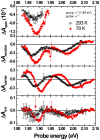Ultrafast multi-level logic gates with spin-valley coupled polarization anisotropy in monolayer MoS2
- PMID: 25656222
- PMCID: PMC4319162
- DOI: 10.1038/srep08289
Ultrafast multi-level logic gates with spin-valley coupled polarization anisotropy in monolayer MoS2
Abstract
The inherent valley-contrasting optical selection rules for interband transitions at the K and K' valleys in monolayer MoS2 have attracted extensive interest. Carriers in these two valleys can be selectively excited by circularly polarized optical fields. The comprehensive dynamics of spin valley coupled polarization and polarized exciton are completely resolved in this work. Here, we present a systematic study of the ultrafast dynamics of monolayer MoS2 including spin randomization, exciton dissociation, free carrier relaxation, and electron-hole recombination by helicity- and photon energy-resolved transient spectroscopy. The time constants for these processes are 60 fs, 1 ps, 25 ps, and ~300 ps, respectively. The ultrafast dynamics of spin polarization, valley population, and exciton dissociation provides the desired information about the mechanism of radiationless transitions in various applications of 2D transition metal dichalcogenides. For example, spin valley coupled polarization provides a promising way to build optically selective-driven ultrafast valleytronics at room temperature. Therefore, a full understanding of the ultrafast dynamics in MoS2 is expected to provide important fundamental and technological perspectives.
Figures






References
-
- Yao W., Xiao D. & Niu Q. Valley-dependent optoelectronics from inversion symmetry breaking. Phys. Rev. B 77, 235406 (2008).
-
- Xiao D., Liu G.-B., Feng W., Xu X. & Yao W. Coupled spin and valley physics in monolayers of MoS2 and other group-VI dichalcogenides. Phys. Rev. Lett. 108, 196802 (2012). - PubMed
-
- Mak K. F., He K., Shan J. & Heinz T. F. Control of valley polarization in monolayer MoS2 by optical helicity. Nat. Nanotechnol. 7, 494–498 (2012). - PubMed
-
- Sallen G. et al. Robust optical emission polarization in MoS2 monolayers through selective valley excitation. Phys. Rev. B 86, 081301(R) (2012).
-
- Zeng H., Dai J., Yao W., Xiao D. & Cui X. Valley polarization in MoS2 monolayers by optical pumping. Nat. Nanotechnol. 7, 490–493 (2012). - PubMed
Publication types
LinkOut - more resources
Full Text Sources
Other Literature Sources

